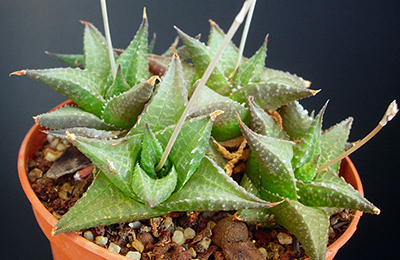Secrets to success when propagating succulent plants
Create more from existing succulent plants through successful propagation.

Succulents are a favorite group of plants for many indoor gardeners. Succulents and cacti are part of the same succulent family. They have the advantage of growing slowly, requiring minimum care and not outgrowing their locations rapidly. They are simple plants; they require direct sun, well-draining soil and rarely, if ever, need to be fertilized. Sandy soils are best. It is possible to purchase cactus mixes that are sandy with a bit of gravel. A great deal of organic matter is not necessary. Watering is done occasionally. When you think of the origin of these plants, a hot, dry climate with lean soils and not a great deal of rainfall give you the framework of what they expect.
Succulents can be propagated in several ways. It is unusual for them to bloom and then produce viable seeds. The usual way is called vegetative propagation. It is essentially creating a clone from the original plant.
Division or separation
Many succulents multiply themselves through division, but some cacti will have small plants appear along the ribs or leaf edges of the plant. When the plantlets are big enough to handle easily, they can be removed. (See the section below about callusing because of the wound created when they are separated.)
With division of other succulents, little plants come up surrounding the parent plant when it is mature. Eventually, more little plants come up and surround the larger surrounding plants and the container is filled. The plant and soil can be taken from the pot and the small plants gently removed. Water the plant well before taking it out of the container so more soil will adhere to the roots. There needs to be roots on the small plants for them to grow. If they are without roots, it may take a long time for roots to form. Pot the little ones in containers. If the little plants are without roots or they broke off, see the information below on callusing.
Cuttings and callusing
A few succulents can be propagated by taking cuttings off the original plant. Sometimes it is because the plant has been damaged or a misplaced elbow and an unceremonious freefall to the floor. Unfortunately, the broken part will not repair and grow again, but the broken segment can be used to generate another plant. The important part is that the broken piece cannot be potted up immediately. It needs a period of time to dry or “callus.”
If the freshly cut piece comes in contact with damp soil, it will rot. Michigan State University Extension recommends letting the cuttings sit for a few days or longer for big pieces. After a period of time, the damp, broken area forms a tough skin or callus over the tissue. The callused plant part can be placed in slightly damp soil. Embed the piece very shallowly. If it is placed too deeply, it will not grow. It may be necessary to support the small plant by having it lean on a craft stick or tongue depressor or against the side of the container. It often takes many months for succulents to form roots. Do not place small plants on a cold window sill or close to a cold window because it will take even longer to grow roots. If a full grown leaf or branch is broken off a succulent like Haworthia or Euphorbia after callusing, it could grow roots. However, if the leaf is broken off Aloe vera, it will not.

Haworthia succulents. Photo credit: Yann Cochard, Wikimedia Commons
There are enough differences in the world of succulents that one size or one rule does not fit all. Smart Gardeners are discovering this continually when learning about plants. Invite a succulent home. They make mannerly and attractive houseguests.
For more information on a wide variety of smart gardening topics, visit the Gardening in Michigan website at www.migarden.msu.edu or contact MSU’s toll-free garden hotline at 1-888-678-3464. You can also visit us at the Novi Cottage and Lakefront Living Show Feb. 26-March 1 in Novi, Michigan; the West Michigan Home and Garden Show March 5-8 in Grand Rapids, Michigan; the Lansing Home and Garden Show March 19-22 in Lansing, Michigan; and the Garden Extravaganza Gardening Conference April 11 in Marquette, Michigan.



 Print
Print Email
Email



